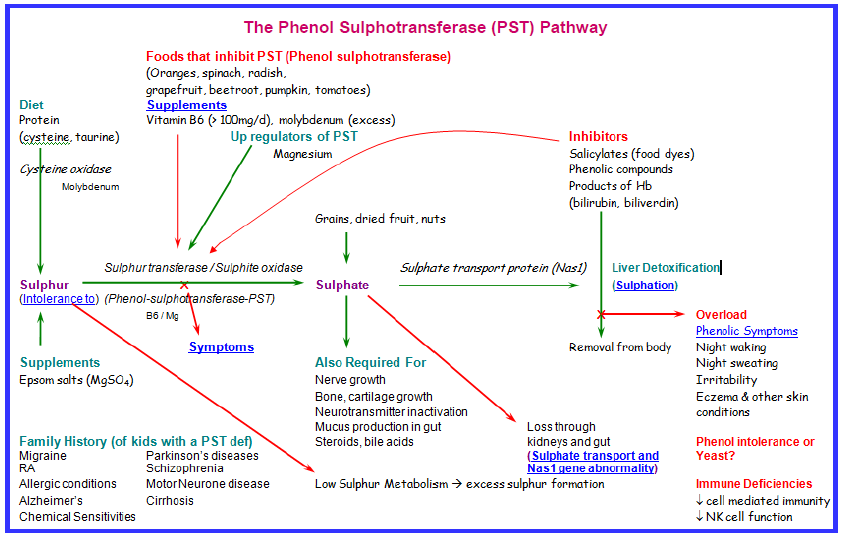What are Salicylates?
Before we look at Salicylate Intolerance itself, lets see what salicylates are. Salicylates are chemicals with salicylic acid as the base. They are a subset of phenols. It acts as a natural pesticide that protects plants against insects and disease. Salicylates are also found in medications (such as aspirin), artificial colours/flavours, preservatives and many beauty and health products. This chemical can have an adverse effect on some people. It is not fully understood by the medical profession and is a condition often misdiagnosed
Salicylate Intolerance
We regularly consume salicylates. Some people are unable to detoxify or metabolise this chemical in their body thus leading to an adverse reaction (1). This condition is known as salicylate sensitivity or intolerance. Depending on how much we eat and how sensitive we are we may accumulate salicylate in our body. If you are unable to effectively break down this chemical effectively you may experience an inflammatory reaction. Each person will have a “threshold” that can be tolerated. It is like a “bucket” effect just like any other food sensitivity.
Symptoms
Many symptoms associated with this condition are related to the central nervous system and gastrointestinal tract. Common symptoms include:
- Headaches or migraines
- Itchy skin rashes such as hives (urticaria), eczema and others
- Stomach pain, reflux in babies or adults, nausea, vomiting, stomach bloating and discomfort, wind, diarrhoea and/or constipation
- Bedwetting, cystitis
- Asthma, stuffy or a runny nose, nasal polyps, frequent throat clearing,
- Behaviour problems such as irritability, restlessness, inattention, oppositional defiance, symptoms of ADHD
- Sleep disturbance – difficulty falling asleep, night terrors, frequent night waking, sleep apnoea
- Anxiety, depression, panic attacks
- Rapid heartbeat
- Tinnitus, hyperacusis, hearing loss
- Joint pain
What Causes Salicylate Intolerance?

- Poor sulfation or lack of PST enzyme – salicylates or phenols in general are removed from the body through metabolism. The Sulfation and glucuronidation pathways play an important role in the metabolism of phenols (2). These are two of the phase 2 live detoxification pathways. The phenol Sulfotransferase (PST) enzyme requires sulfates to breakdown phenols. Depending on how prevalent or active the enzyme is in your body each person’s ability to detoxify salicylates will differ.
- Leaky gut – Leaky gut (4) is a condition where the bacteria and other foreign particles are able to “leak” through the walls of the gut due to increased intestinal permeability. Even though it is not proven, when you have a leaky gut foreign pathogens such as salicylates can enter the bloodstream.
- Small intestinal bacterial overgrowth (SIBO) – Have you read my article on SIBO? According to Dr. Donna Beck (5) an expert in this subject, SIBO could cause gut permeability that can lead to malabsorption of foods such as salicylates.
Have a look at this video to learn more about this condition.
https://www.facebook.com/AmyMyersMD/videos/10156272233924175/
Testing for Salicylate Intolerance
Like any other food sensitivity diagnosing this condition is difficult as symptoms overlap with many other similar conditions. I struggled with it for many years not knowing exactly what it is.
- Elimination Diet – The gold standard for diagnosing this condition is an elimination diet along with a food & symptom diary. An elimination diet involves being on a diet that is low in salicylates for 4 weeks. I know it is practically impossible to find food that have no salicylates. Once the body has gotten rid of the stored salicylates you should see an improvement in your symptoms if you are salicylate intolerant. You can then slowly re-introduce foods one at a time (start with the foods that are low and then gradually move to medium and then high). Make sure you keep a dairy of the food and your symptoms. This helps to identify the foods you are sensitive to and what is your threshold.CARE SHOULD BE TAKEN if you like to try an elimination diet on a child as it needs to be attempted under medical supervision.
- Organic Acid Test (OAT) – OAT is a comprehensive gut that test for a number of markers including vitamins/antioxidants, detoxification, methylation, oxalates, gut microbiome and digestion. The marker specific to salicylates is 2-Hydroxyhippuric Acid. Elevated levels of this marker could indicate poor phase 2 liver detoxification (among many other possible reasons). You will need to consult a qualified practitioner to interpret results.
- Vega Machine – We came across the Vega machine during one of our visits to the naturopath. This is a device that uses acupuncture points to measure the electrical disturbance to a person’s energies when they come into contact with specific foods or substances which affect them adversely. Energy medicine (the theory behind the Vega machine) is not recognised by medical science but I found it useful in pointing to my daughter’s food sensitivity and it gave a fairly accurate picture on the food that gave her adverse reactions (6). Ofcourse we had to correlate the recommendations from the naturopath and her symptoms but atleast it have a starting point.
Does Salicylate Sensitivity Lead to Other Digestive Conditions?
Some research suggests that salicylate sensitivity may lead to other digestive conditions such as inflammatory bowel disease, ulcerative colitis and Crohn’s disease (7).
Managing Salicylate Sensitivity
There are a number of things you can do to manage this condition.
Low Salicylate Diet/Lifestyle
Once you have performed an elimination diet, you should have got a good idea of your threshold to foods and if you are indeed salicylate intolerant. On a low salicylate diet you will avoid foods that are from the high or moderate categories for 4 weeks.
- Limit foods from the high and moderate category for 4 weeks
- Re-introduce foods one at a time and observe any symptoms
- Wait for 72 hours to see if there are any symptoms (yes, food intolerance symptoms can take a while to manifest)
- Remove any foods that triggered the symptoms and continue with foods that did not trigger any symptoms
- Continue to improve your overall gut health and address any root cause that may have caused the condition
- Continue to introduce new foods and retry previously tried foods that could not be tolerated (after 3 months)
The following are important considerations:
- It is important to keep a food and symptom diary during this entire process
- Many foods high in salicylates are also nutritious, so it is important not to restrict them in the long term
- Salicylates occur not only in our food, but also in non-food sources. These include many health & beauty products, medications and herbal remedies. Checkout my salicylate food list for more details. It is important that you avoid consuming/using these non food items as well.
If you are attempting this for a child, it needs to be done under medical supervision, as it is always important for a growing child to get the right amount of nutrition.
Support Salicylate Metabolism
Your liver is the primary organ that is responsible for salicylate metabolism. The kidney being the other. Helping the glycine pathways and glucuronidation, will help to improve salicylate metabolism. There are vitamins and supplements that can help here.
- Vitamins B1, B2, B5 and B6, Zinc and Magnesium – These help the body produce sulphate the liver needs to metabolism salicylates
- Epsom salt baths – Epsom salt is magnesium sulphate. Either using sprays or baths to get this substance can help. Both methods worked well with my daughter, although I could only use a small amount of the spray on her skin, as it would irritate her skin otherwise.
- Calcium D Glucarate – It helps with the glucuronidation, making the salicylate more water-soluble. This is one of my favourite supplements. It helped both my son and daughter.
- Glutathione – Known as the master antioxidant, it is found in every cell of the body. Supplementing glutathione can improve overall metabolism process and also getting rid of harmful by products of the salicylate metabolism process.
- Omega 3 fatty acids – Maintaining a healthy ratio between Omega 6 and Omega 3 (ratio of 4:1) is important as having a higher can lead to inflammation (8). Check out the research paper on how salicylate sensitivity has been controlled with the aid of fish oils. Supplements with Omega 3 such as Cod Liver Oil has proven to help treat salicylate sensitivity. My favourite brand is Carlsons Cod Liver Oil
Heal and Seal Gut
Restoring the gut lining and maintaining a healthy balance of gut microbiome is an important aspect.
- Probiotics – Most of those having salicylate intolerance will opt for a low salicylate diet, which in turn leads to an un-balanced diet. The side effects being the gut microbiome getting out of balance. In order to restore it you need to introduce ‘good’ bacteria into the gut. Certain strains such as D lactate free probiotics have been proven to be beneficial for those with this condition. We tried about 15-20 different strains and eventually it was Spectrumceutical’s Pro 450 D lactate free product that worked wonders for us.
- L-Glutamine – A dominant amino acid in the body, it helps to strengthen the gut lining. A strong and healthy gut lining will prevent any ‘particles’ from infiltrating into the blood stream directly and also help with better production of digestive enzymes.
- Slippery Elm and Aloe Vera – These herbs offer a protective layer and sooth the mucosal layer of the digestive system. They also sooth the gut when you from stomach cramps.
Use Binders
Toxaprevent, TRS and Activated Charcoal – Binders are great to get rid of excess salicylates or for that matter many toxins from the body. We used Toxaprevent as a stop-gap measure initially and helped my children to get relief from all the effects of their intolerances. Binders absorb the toxins and exit from the body naturally. Alison Vickery has a great article on binders here. I highly recommend TRS (from Coseva) and Toxaprevent as they have both worked for us
Take Suitable Supplements
Although I am not a fan of too many supplements, at times it is necessary to take some supplements at-least for a certain period.
If you are struggling with food intolerances or other digestive problems, there are products that can help YOU. This list has been compiled through my own experience as well as working together with trusted and experienced practitioners worldwide.
Click to Get My Recommended Supplements ListFood Guide
The Salicylate food, non-food guide can be found here.
Related Conditions
Many who have histamine intolerance have shown symptoms of histamine intolerance and glutamate intolerance as well. Both my kids have these 3 conditions.
Disclaimer: The content provided in this article, and in any linked materials, are not intended and should not be construed as medical advice. If the reader or any other person has a medical concern, he or she should consult with an appropriately licensed physician or certified health care worker who can provide personalised advice.
References
- Hanns-Wolf Baenkler, Prof, Salicylate Intolerance – Pathophysiology, Clinical Spectrum, Diagnosis and Treatment. PMID 19633779. Link here https://www.ncbi.nlm.nih.gov/pmc/articles/PMC2696737/
- Shangari N, Chan TS, O’Brien PJ, Sulfation and glucuronidation of phenols: implications in coenyzme Q metabolism. PMID 16399359.
Link here https://www.ncbi.nlm.nih.gov/pubmed/16399359 - Muhammad Bilal Hussain, Sadia Hassan et al, Bioavailability and Metabolic Pathway of Phenolic Compounds, Published: June 28th 2019 (peer reviewed paper). Link here https://www.intechopen.com/books/plant-physiological-aspects-of-phenolic-compounds/bioavailability-and-metabolic-pathway-of-phenolic-compounds#B65
- Is Leaky Gut Real? Link here https://www.healthline.com/nutrition/is-leaky-gut-real
- Salicylate Sensitivity and SIBO with Dr. Donna Beck. Link here https://www.thesibodoctor.com/2017/02/02/the-sibo-doctor-podcast-episode-4-salicylate-sensitivity/
- The dietary management of food allergy and food intolerance in children and adults by the Dieticians Association of Australia. Link here https://www.slhd.nsw.gov.au/rpa/allergy/research/daareview.pdf
- Significance of salicylate intolerance in diseases of the lower gastrointestinal tract, Raithel M, Baenkler HW et al. PMID: 16247191. Link here https://www.ncbi.nlm.nih.gov/pubmed/16247191
- Control of salicylate intolerance with fish oils. Healy E, Newell L, Howarth P, Friedmann PS. PMID: 18795922. Link here: https://www.ncbi.nlm.nih.gov/pubmed/18795922

